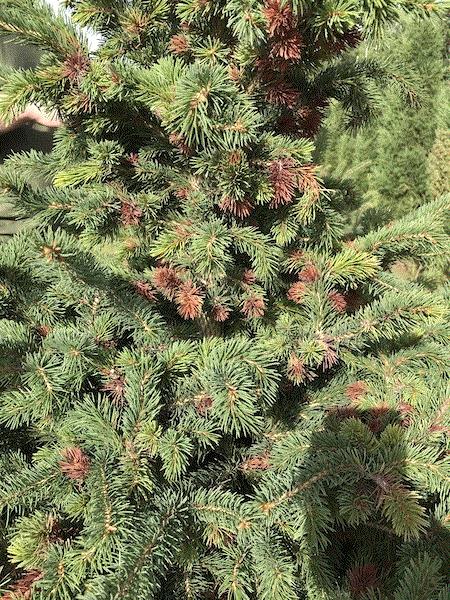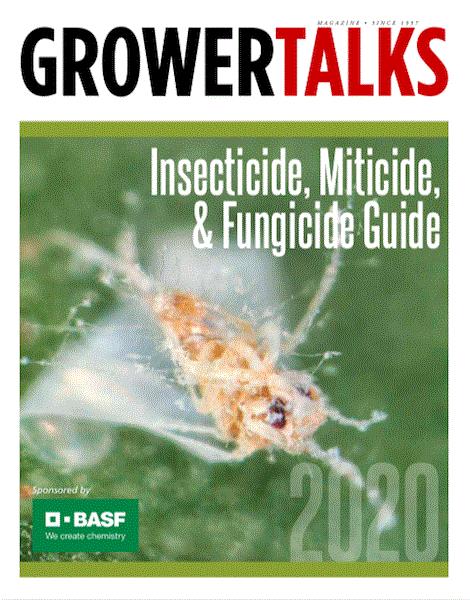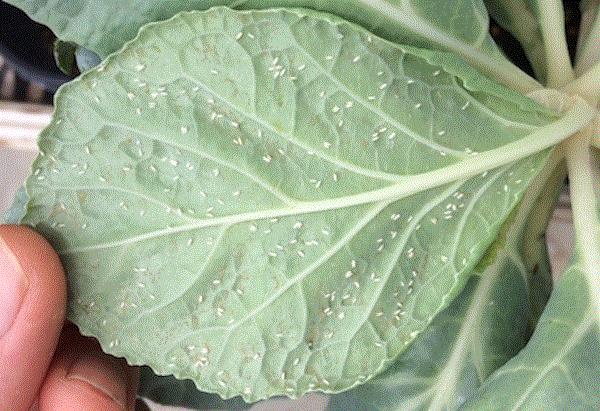What the … ?
I met Grace Owen of Bachman’s Nursery in Minnesota at an educational event organized by Winfield United. Unfazed by my seemingly bumbling way of making pest management recommendations, Grace and I have been communicating on pest management issues.
Grace sent me a few pictures in August, which show many dead shoots on a Black Hills spruce. As soon as I heard “Black Hills spruce,” I knew it was not something I’m familiar with. Grace kindly let me share a picture on this newsletter.
What do you think is causing the problem?

What happened to the Black Hills spruce? (Photo credit: Grace Owen)
The 2020 GrowerTalks IMF Guide is available
You would think, after spending the last 12 years writing impact statements for every dollar I spent for work, I would have developed an innate ability to seize on a product of significance and promote it. Well, the idea hasn't quite gotten through that thick skull of mine. Case in point—I haven't mentioned anything about the 2020 GrowerTalks Insecticide, Miticide & Fungicide Guide even though it has been published for almost a month! I blame all the other fun (and distracting) things I can write about.
So, without further ado, here is the 2020 GrowerTalks Insecticide, Miticide & Fungicide Guide, sponsored by BASF. (Cue the fireworks!) You can find the IMF Guide, as well as the Annual PGR Guide and the Perennial PGR Guide, by clicking here. Or, look for the September issue of GrowerTalks on top of that pile of trade magazines you keep on your desk.

As in years past, the 2020 edition includes a comprehensive list of insecticides, miticides and fungicides registered for the major insects, mites and diseases in floricultural production. The pesticides are listed by target pests and diseases, active ingredients, trade names and IRAC or FRAC group codes.
The IMF Guide also includes several technical articles. Ray Cloyd of Kansas State University contributed an article on how to use pesticides appropriately, and I wrote an article, “These Guys Suck!,” based on a GrowerTalks webinar of the same title I gave some months ago. Jen Browning and Kathie Kalmowitz of BASF gave some tips on how to use Ventigra (BASF’s newest insecticide) and Intrinsic Brand fungicides, respectively. Our very own editor of Perennial Pulse, Paul Pilon, outlined the uses and benefits of pyraclostrobin fungicides. Dave Norman of the University of Florida contributed a piece on how to identify and manage bacterial diseases. These articles will give you a lot of useful tips and technical information to make you a better pest manager.
By the way, those trade magazines on my office table go back to 2009 (not really a badge of honor, I know). How far back do yours go? And, I wonder what Matthew Chappell (Nursery and Landscape Insider) meant by the “sarcastic and humorous” place the abbreviation “IMF” can take you. You’ll have to ask him, but try to keep a straight face.

The biggest, baddest pest and disease issues of 2019
I attended the IR-4 Environmental Horticulture Program’s Priority Setting meeting a couple of weeks ago. Researchers and representatives of growers, pesticide manufacturers and distributors gathered to discuss the major pest and disease issues faced by the green industry, identify research priorities for the next two years and develop approaches to achieve these priorities and goals.
A tool the meeting attendees used to identify research priorities was the Grower Survey conducted by IR-4. The pest and disease issues identified as the top priorities by the Grower Survey are often selected as research priorities. I’ve encouraged y’all before: if you want IR-4 or the research community to take your pest problems as a priority, you’ll have to complete the survey. Y’all did, didn’t you? Check out the results of the 2018-2019 survey by clicking here.
Over 60% of the survey respondents were growers, and those who work in greenhouses, container nurseries and field/in-ground nurseries made up the largest groups at roughly equal proportions (21-24% each). These growers produce a variety of horticultural crops, with bedding plants, perennials, shrubs and trees being the major products (11-14% each). The largest chunk of the respondents hailed from the West (46%), followed by the South (26%), Northeast (18%) and North Central (11%).

Is whitefly one of the baddest pests in 2019 according to IR-4's Grower Survey? Check out the survey results to find out.
So, what are the major pest problems? Thrips; mites and spider mites; borers and beetles; scales and mealybugs; and aphids are the top five pest groups in decreasing order of importance. Thrips was identified as the most important pest in greenhouse and field nurseries, and for bedding plants, seasonally potted plants, cut flowers, foliage plants and perennials. Borers and (leaf) beetles are the biggest issues for trees and shrubs, as are snails and slugs for ornamental grasses.
For the diseases, the top five groups are bacterial diseases; botrytis; phytophthora and pythium; leaf spots and anthracnose; and crown and root rots. Bacterial diseases are ranked as the most important issue across all production systems, i.e. greenhouse, (container and field) nursery and landscape, as well as in production of ornamental grasses. Botrytis is the most important issue on cut flowers, foliage plants and perennials. Crown and root rots are important to bedding plant producers, and leaf spots and anthracnose are the most important for shrub and tree growers.
The top five weeds are perennial broadleaves, summer annual broadleaves, grasses, horsetail and similar weeds, and liverworts, moss and algae. Perennial broadleaves are the most important issue for all production sites, whereas liverworts, moss and algae are ranked second and summer annual broadleaves are ranked third for greenhouses, field nurseries and container nurseries. Liverworts, moss and algae are most important for the bedding plant and ornamental grass producers. Perennial broadleaves are the most important for the shrub, tree, foliage and perennial growers. For cut flower producers, the biggest issue appears to be grassy weeds.
Do these rankings reflect what you are dealing with? There are so many nuances in these rankings that you definitely need to check them out on your own.
There is also lots of information about how respondents manage their pest problems and protect their beneficials and non-targets (including pollinators). Check out the survey results; I guarantee it’s an interesting read.

Answer to “What the … ?”
Grace didn't need me to identify the problem for her—she correctly identified the culprit as spruce gall midge, a tiny fly whose maggots feed within the shoots, causing swelling and eventual death.
I don't know much about this pest. Its common hosts—white, Norway and Black Hills spruce— ain’t something I commonly see in the landscapes of the South. So I have to find what I can from references and recite them as if I know something. Grace knows more about this pest than I do. What we did was talk about the management approaches she had come up with.
Spruce gall midge has only one generation a year. They overwinter as larvae deep in the swollen shoots or galls. Few insecticides are effective against these maggots because they are well-hidden and protected within the shoots. You’ll have to hit them before the maggots bore into the plant tissues. The best application timing is around late April and early May, when adults are active in the Midwest. The insecticides sprayed or their residue on the plant surface can kill the hatchlings before they bore into the shoots. Very few chemicals are registered specifically for managing gall midges. Few studies that evaluated insecticide efficacy against spruce gall midge have been published. (If you find more, please let me know!) Organophosphates were shown to be the most effective in a study conducted in Connecticut. I think pyrethroids can also be effective. Based on my experience against other midges, spinosad (Conserve) and abamectin (Avid) are also effective (but I haven’t tested these products against spruce gall midge). The insecticides may have to be sprayed two to three times on a biweekly basis.
The adults are tiny, so they may be a bit difficult to find. I wonder if an alternative scouting method might work? Here is what I’m thinking: collect some of the galls, put them in a bag or glass jar, close the bag or jar, put it back into the canopy, and check on them regularly to look for the tiny yellow flies from mid-April to early May. I think fine organza or mesh bags (you can find these at craft stores) would be better since they allow air movement; the galls may cook in sealed glass jars if the jar gets hot. Once the adults are found, the spray program can begin.
Of course, if the infestation is not severe, pruning off and discarding or burning the dead shoots in the spring is always a great way of removing infestation.
In Memoriam: Dr. Paul Thomas
The last piece of news this week is not a fun one to write about. I’m still processing the news.
I was shocked when I received word that Dr. Paul Thomas, who had only recently retired from the University of Georgia and embarked on a new career as the ambassador of American Floral Endowment’s (AFE) internship program, passed away at the age of 65 doing what he loved—engaging students in the horticultural industry. I had been one of those students, myself.
Matthew Chappell summed up nicely what Paul has done for our industry in last week’s Nursery and Landscape Insider. I was in Colombia attending Proflora (one of the world’s largest cut flower trade shows) last week, and Paul was constantly in the thoughts and conversations of those who knew him.
We miss you, Paul.
See y'all next time!

JC Chong
Professor of Entomology at Clemson University
This e-mail received by 22,140 subscribers like you!
If you're interested in advertising on PestTalks contact Kim Brown ASAP!